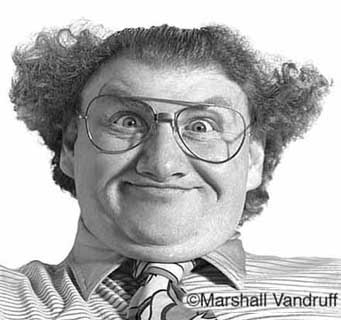
If another Great Depression is in our future, what kind of media will the public demand? My guess is something flamboyant and cathartic, something that'll focus our attention on other people's problems rather than our own...maybe the same kind of story that caught on in the last depression, maybe something gruesome and stylized with lots of action, something like...like the pulps!

If that's the case, then this crisis has a silver lining. The pulps were great! The covers alone were worth the price, and the writing was sometimes surprisingly good. Even the names of the stories were great: how do you like (above)"The Mole Men Want Your Eyes"?

Here's (below) an excerpt from a gangster story. An odd man walks into a diner and has a cup of coffee. When it's time to go...
He stood up unsteadily while his right hand
went to his pocket and came out clutching a dime.
He spun it on the marble counter in the direction of
the pockmarked waiter.
“It’s all I have,” he said sort of cheerfully. “But
I won’t be needing more where I’m going,” he
added.
Then he turned about and faced the front, drew
in a deep breath, threw out his chest, set his mouth
in a grim, thin line and made for the door with eyes
fixed straight ahead.
“Good-by,” he said, as he strode out into the
darkness of the deserted street, still erect, still with
perfect control.
“Good-by,” the waiter repeated dazedly, simply
because he could think of nothing better to say.
HE cold sweat beads stood out lividly on the
Kid’s pasty forehead now. His teeth crunched
and his knees began to tremble just as he stepped
over the threshold and down the single step to the
sidewalk.
The waiter turned his head away and closed his
eyes.
Rat a-tat-tat! Trr-r-r-r-r-r!
A screaming fusillade of sub-machine-gun slugs
splattered against the brick front of the Coffee Pot,
ricocheted off the walls and crashed the plate glass
windows with shattering impact.

Black Mask (above) was for pulp readers with a literary bent.

Here's (below) a story about the Yellow Peril, something that pulps were obsessed with. Here a female Chinese torturer is taken by surprise when the soldier of fortune manages to slip out of his restraints:
The torture-woman backed away, her features
suddenly pale. Shevlin sprang at her. She leaped
backward—
Leaped backward, and crashed full against the vat
of molten lead! It overturned on its stand. The half-
caste woman shrieked in sudden agony as the liquid,
white-hot metal cascaded over the sides of the tottering
vat and ate into her yellow flesh.... She swayed,
staggered, grasped at the sides of the vat to steady
herself. Then, as she toppled to the floor, she pulled
the huge pot of molten metal crashing over on her.
Bubbling molten lead streamed thickly over the
woman’s unclad body in a fiery Niagara of death!
But Tate Shevlin was not looking. He had flung
himself toward the rack upon which the Golden Girl
was bound. Now he slashed at her bonds with his knife.
The leather thongs parted. He started to lift her—
“One more move and I’ll shoot you where you
stand, dog!” a harsh voice snarled from the doorway.
Shevlin whirled—and stared into the muzzle of an
automatic in the hands of General Wu Shang!

Sometimes even the manly adventure pulps ran humorous stories (below):
What a mess for a guy like him to get in, he
thought to himself as he peered at the faint
outlines of the girls’ almost totally unclothed
bodies. Three girls! And he alone with them!
But it wasn’t his fault. The night before
when the gambling ship on which Tuffy worked
as deckhand had been raided by government
officials off the coast of California, he had
suddenly found himself pushed into the boat
with the three girls and told to stay out of sight
while the raid was on.
For an hour they had crouched in silence a
few feet away from the ship. Then, before their
startled eyes, the boat had pulled up anchor and
slipped off into the darkness. They had been
forgotten or deserted, one of the two. It didn’t
matter which.
And here they were, Tuffy Scott, with a
black stubble of beard on his roughly handsome
face, and three blonde girls in dance outfits
consisting of tiny red silk panties.
You have to like men. We're such simple creatures. Give us a story with three naked women on a raft with one man and we're happy.

Men like weird anamalies too. Here's a paragraph from a story (below) about a murderous bag lady. She decides to bump off another bag lady who's carrying her hard-won life savings in the lining of her coat. In the shadows of a big city alley the two fight it out. Here's (below) how the author describes the motivation of the murderer:
"Annie wanted that money! She was determined
to have it, no matter what the cost. She vaguely
realized she was young no longer. Being ugly in the
bargain made it difficult to make the man she loved
notice her, not to talk of his falling for her. She was
crazy about Joe Thompson who hung around Mick’s
Poolroom Parlor all the time. There was only one
way to make that guy and keep him . . . with money!
If there was enough of it, who knows? He might
even get to marry her. She’d hook him, one way or
the other. All she needed was money and a couple of
gladrags."

Here's (above) a scene I'd love to do in animation: A robotic salt-shaker chicken runs off with a girl, and is pursued by futuristic motorcycle police across a golf course...the audience would love it!























.JPG)





















